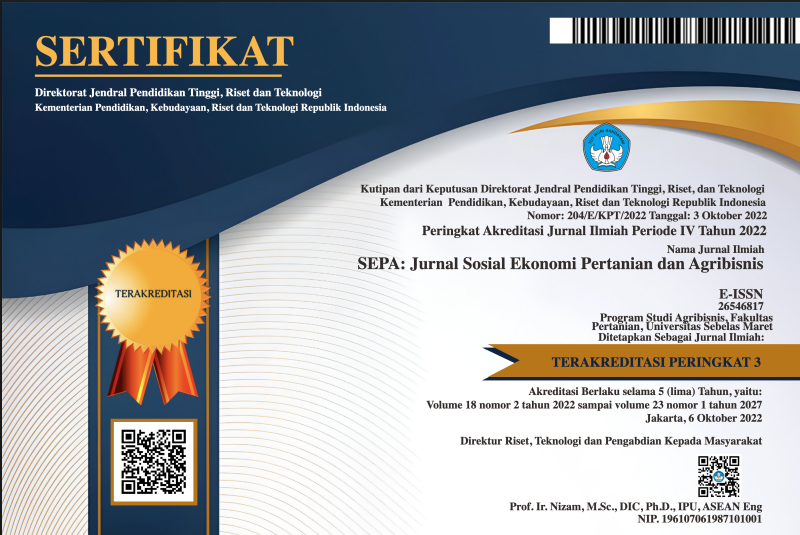KINERJA DAYA SAING TEH HIJAU INDONESIA DI PASAR INTERNASIONAL
Abstract
Keywords
Full Text:
PDFReferences
Anggraini, T. (2017). Proses dan Manfaat Teh. Padang: CV. Rumahkayu Pustaka Utama. Retrieved from http://carano.pustaka.unand.ac.id/index.php/car/catalog/view/41/38/126-1
Arbella, S. D., & Widodo, P. (2023). Indonesia ’ s tea competitiveness with Russia. International Journal of Research in Business and Social Science, 12(3), 558–556.
Badan Pusat Statistik. (2023a). Produk Domestik Regional Bruto Provinsi-Provinsi di Indonesia Menurut Lapangan Usaha 2018-2022. Jakarta: Badan Pusat Statistik.
Badan Pusat Statistik. (2023b). Statistik Teh Indonesia 2022. Jakarta: Badan Pusat Statistik.
Balassa, B. (1965). Trade Liberalisation and “Revealed” Comparative Advantage. The Manchester School, 33(2), 99–123. https://doi.org/https://doi.org/10.1111/j.1467-9957.1965.tb00050.x
Esterhuizen. (2006). Measuring And Analysing Competitiveness In The Agribusiness Sector: Methodological And Analytical Framework. Retrieved from https://api.semanticscholar.org/CorpusID:56414245
Gunawan, M., & Ryandinni, N. (2023). Analysis of the Export Potential of Indonesian Processed Green Tea Products Through Export Market Mapping by Empowering International Trade Digital Data. Atlantis Press SARL. https://doi.org/10.2991/978-2-38476-110-4_120
Hasibuan, A. M., Nurmalina, R., & Wahyudi, A. (2012). Analisis Kinerja dan Daya Saing Perdagangan Biji Kakao dan Produk Kakao Olahan Indonesia di Pasar Internasional. Buletin RISTRI, 3(1), 57–70. https://doi.org/10.21082/jtidp.v3n1.2012.p57-70
Indonesia Trade Promotion Center Osaka. (2022). Laporan Analisis Intelijen Bisnis. Indoensian Trade Promotion Center, 1–43.
International Trade Centre. (2024). Trade Statistics for International Business Development. Retrieved from https://www.trademap.org/
Jakarta Futures Exchange. (2018). Kontrak Perdagangan Fisik di BBJ Dongkrak Harga Teh Nasional. Retrieved July 17, 2024, from Artikel JFX website: https://www.jfx.co.id/media?hal=artikel-detail&id=108
Khaliqi, M., Gurning, H. R. H., Novanda, R. R., & Simamora, O. N. (2020). Competitiveness Indonesia tea in international market. IOP Conference Series: Earth and Environmental Science, 454(1). https://doi.org/10.1088/1755-1315/454/1/012039
Kusuma, R. L., & Firdaus, M. (2015). Daya Saing dan Faktor yang Memengaruhi Volume Ekspor Sayuran Indonesia Terhadap Negara Tujuan Utama. Jurnal Manajemen Dan Agribisnis, 12(3), 226–236. https://doi.org/10.17358/jma.12.3.226
Muflihah, U., Mutolib, A., & Nuraini, C. (2023). Analysis of Indonesian Tea Export Competitiveness on the International Market. East Asian Journal of Multidisciplinary Research, 2(10), 4209–4216. https://doi.org/10.55927/eajmr.v2i10.6354
Nayantakaningtyas, J. S., Daryanto, A., & Saptono, I. T. (2017). Competitiveness of Indonesian Tea in International Market. Indonesian Journal of Business and Entrepreneurship, 3(1), 14–23. https://doi.org/10.17358/ijbe.3.1.14
Nugroho, A. P. (2021). Efektivitas Kerjasama Indonesia-Pakistan Dalam Kerangka Indonesia-Pakistan Prefential Trade Agreement (Ip-Pta) Terhadap Ekspor Teh Indonesia Ke Pakistan (2013-2017). Moestopo Journal International Relations, 1(2), 94–106.
Nursodik, H., Santoso, S., & Nurfadillah, S. (2021). Competitiveness and Determining Factors of Indonesian Tea Export Volume in the World Market. Habitat, 32(3), 163–172. https://doi.org/10.21776/ub.habitat.2021.032.3.18
Putri, I. R., Priana, W., & Wahed, M. (2021). Analisis Faktor-Faktor yang Mempengaruhi Ekspor Teh Indonesia Ke Malaysia. Jurnal Syntax Admiration, 2(6), 1066–1082. https://doi.org/10.46799/jsa.v2i6.242
Rohdiana, D. (2015). Teh : Proses, Karakteristik & Komponen Fungsionalnya. Foodreview Indonesia, 10(December), 34–37.
Simalango, M., Fadil, C., & Imaningsih, N. (2023). Analisis Daya Saing Ekspor Teh Indonesia di Pasar Global Tahun 2017-2021. Jurnal Ilmiah Wahana Pendidikan, 9(September), 458–464.
Startienė, G., & Remeikienė, R. (2014). Evaluation of Revealed Comparative Advantage of Lithuanian Industry in Global Markets. Procedia - Social and Behavioral Sciences, 110, 428–438. https://doi.org/10.1016/j.sbspro.2013.12.887
Tupamahu, Y. M., & Kamisi, H. La. (2022). Kinerja Ekspor Teh Indonesia. Jurnal Agribisnis Perikanan, 15(1), 249–254.
Yudha, E. P., & Rasita Malau, H. E. (2022). Analisis daya saing ekspor jeruk Indonesia, Singapura dan Thailand ke pasar Malaysia pada periode 2013-2018. EQUILIBRIUM : Jurnal Ilmiah Ekonomi Dan Pembelajarannya, 11(1), 1. https://doi.org/10.25273/equilibrium.v11i1.13752
Zuhdi, F., & Rambe, K. R. (2021). Daya Saing Ekspor Cengkeh Indonesia Di Pasar Global. SEPA: Jurnal Sosial Ekonomi Pertanian Dan Agribisnis, 17(2), 165. https://doi.org/10.20961/sepa.v17i2.43784
Zuhdi, F., Rambe, K. R., & Rahmadona, L. (2022). Analysis of Competitiveness and Forecasting of Indonesian Tea Exports to Main Destination Countries. Media Ekonomi Dan Manajemen, 37(2), 240. https://doi.org/10.24856/mem.v37i2.2888
DOI: https://doi.org/10.20961/sepa.v21i2.84185
Refbacks
- There are currently no refbacks.



.png)







.png)
3.png)





